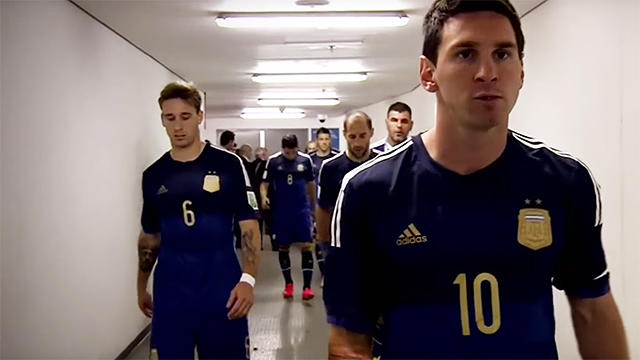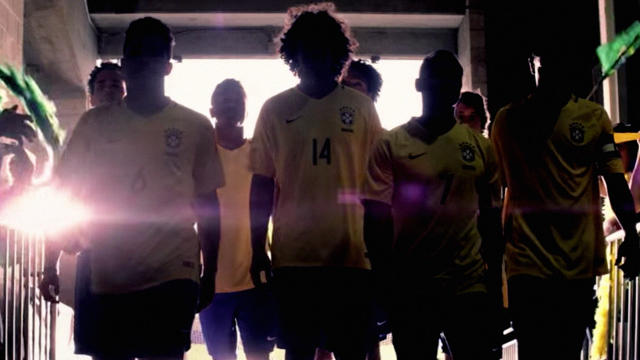How Copa America Is Selling Itself To American Sports Fans
This week, the Copa America Centenario soccer tournament kicks off in the U.S., featuring top-rated international teams such as Argentina, Brazil, Chile, Uruguay, as well as global superstars such as Lionel Messi, Luis Suarez, Chicharito, and more. It’s the first time this century-old competition has been held on American soil, and the first time most of these players have played meaningful matches in front of U.S. fans.
While it’s long been a marquee competition in South America, the Copa isn’t as familiar to American audiences, even casually, as even the European Championships (which are also happening this summer in France). But the Copa presents a unique set of challenges and opportunities for organizers and major brands looking to tap into the soccer audience, and get a wider audience interested in the sport.
U.S. Soccer’s chief commercial director Jay Berhalter says that the Copa America will be the biggest soccer event in the U.S. since it hosted the 1994 World Cup. In fact, the Copa may be an overall tougher competition than Euro 2016. It features 5 of FIFA’s top 10-ranked teams, and, of the final 16 teams in the World Cup 2014, the Copa features 8 teams in its 16-team field, while the Euros have just 6 among its 24 teams.
Berhalter sees this tournament as another major step in the growth of the sport in the U.S. And while the arrival of soccer as a major American sport has been long predicted—as the Men in Blazers often declare, it’s been America’s sport of the future since 1972—but over the last decade we’ve seen an acceleration in U.S. fans’ embrace of the game, and Berhalter points to a handful of significant trends driving it.
“First, the diversity of the country, where the population is changing,” says Berhalter. “We now have people graduating college that have never known a sports landscape without MLS [Major League Soccer]. Secondly, with the convergence of digital tools—Facebook, Twitter, Whatsapp—there are no barriers to following any team or player around the world. It used to be really tough to find the game in this country, and now there are more soccer games on TV here than in any other country in the world. Last year we saw something like 3,500 live soccer games on TV in the U.S. That averages out to eight games a day. And you can watch what you want, when you want. So those digital tools, along with global connectivity work as one, where you can be a fan of Lionel Messi or Alex Morgan, or their local MLS team, and the access to games is pretty much the same.”

Finally, there’s a little thing called patriotism. The swell of support that started with the men’s team at the 2014 World Cup, simply exploded for the women’s team, which won the 2015 World Cup and set TV ratings records along the way. The American 5-2 win over Japan in the final game had the largest U.S. TV audience for any soccer game ever. Fox, the tournament’s broadcaster in the U.S., has wrapped its network TV stars in the flag, using the stars and stripes as a gateway for a wider swath of American sports fans to watch soccer.
“The idea of supporting the country and rallying around the flag has taken hold in a whole new way in soccer,” says Berhalter. “We’ve seen that manifest in the last four or five World Cups, but in particular with both the men’s and women’s teams in 2014 and 2015, taking it to the next level. At the Copa, we’ll see that from many different countries in our country.”
While soccer fans understand what the Copa is and what it means, Berhalter says they’ve altered their marketing strategy to reach a broader U.S. sports audience. That strategy can be summed up in three words: Americans love superstars.

“As you start to go to a broader audience, you’re really talking about the world’s best players coming to this country, and people like Messi, Suarez, Chicharito, and James have achieved a recognition in this marketplace that is far beyond even where it was two or three years ago,” says Berhalter. “When you look at the amount of highlights played on TV or other outlets, the increase has been significant. That’s been our approach, to try to articulate that these top players will be playing meaningful matches in the U.S. and you can see it live.”
Kathy Carter, president of Major League Soccer’s commercial arm Soccer United Marketing (SUM), says one of the Copa’s major attractions is the sheer size of the soccer spectacle itself. “Americans love to be involved with big events,” says Carter. “We knew that tickets for a World Cup-like tournament on U.S. soil would sell, and we’ve been very pleased with the numbers we’ve seen. We’re ahead of early projections. We also know that once the tournament begins that the media attention and buzz surrounding the event will start to draw in some of the casual sports fans.”

As with most big soccer tournaments, major brands like Nike, Ford, and Coke have jumped on the Copa bandwagon, but we haven’t seen the same level of full-court press of marketing as, say, Euro 2016 or a World Cup. According to Berhalter, that’s likely due to the short planning time frame around the competition. SUM has only had the opportunity to be in the market since December.
“For a tournament of this magnitude, that is a very, very short time frame,” says Berhalter. “But I think if you look at the roster of partners who have signed on, that alone is a real indicator of, first the great job SUM has done, and secondly that these brand partners recognize the magnitude of this event. Ultimately the time frame is a challenge. That’s not an excuse—we knew when we tried to bring this competition back on the table, our eyes were open. But clearly if you were to say, if we could do it all over again, the one thing we’d say is that more time would be great from an operating and promotion perspective.”
Coca-Cola is a familiar sight at all major soccer events, and the Copa is no exception. The brand is launching a number of TV and digital ads as the tournament kicks off, including a new Powerade spot that profiles Mexican national team star Jesus “Tecatito” Corona, an extension of the brand’s “Just A Kid” campaign that has featured NBA star Derrick Rose and NFLer Jimmy Graham.
Ultimately, Berhalter sees the Copa as a good opportunity to showcase how far the U.S. has come in the game, and what its capabilities are from both a fan and brand perspective. “That we can pull off a world-class competition with six-months planning is something that’s pretty unique to the U.S.,” says Berhalter. “The fact we’ll have 10 or more world-class brand partners get involved in that short time frame, again, is a testament to their belief in the market and competition. When we look at where this takes us, it’s an indicator of how bright the future is for the sport in this country.”
Fast Company , Read Full Story
(43)



